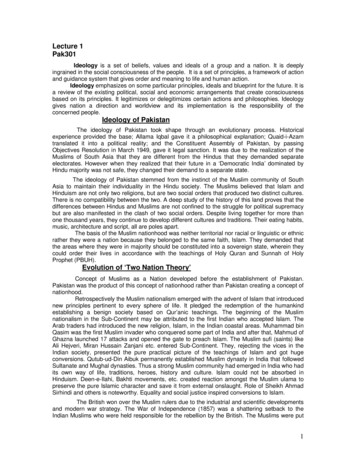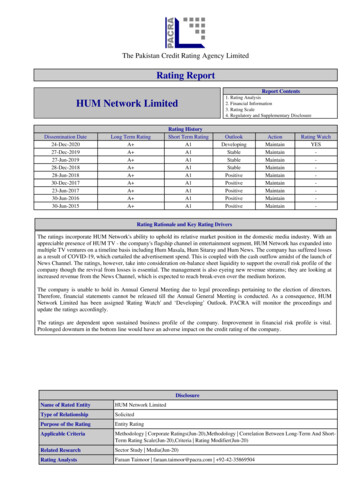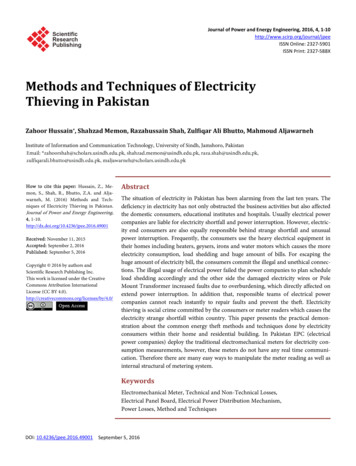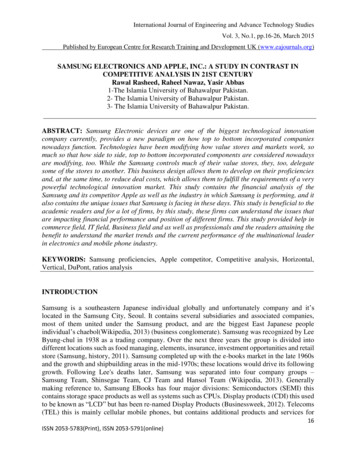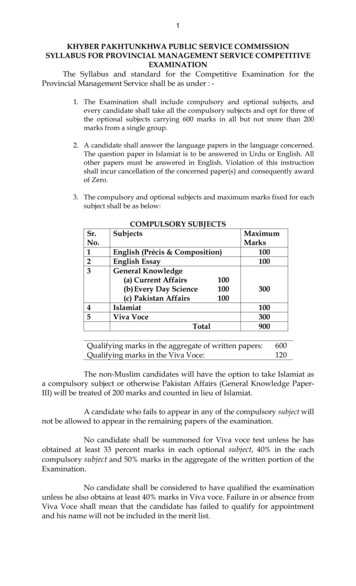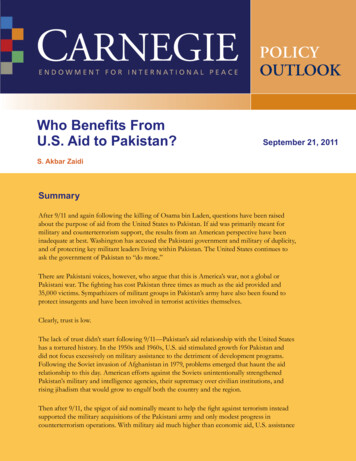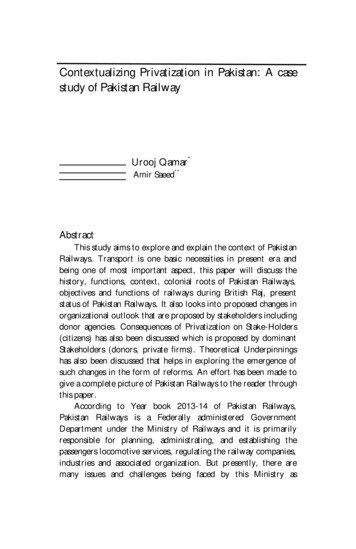
Transcription
Contextualizing Privatization in Pakistan: A casestudy of Pakistan RailwayUrooj Qamar*Amir Saeed**AbstractThis study aims to explore and explain the context of PakistanRailways. Transport is one basic necessities in present era andbeing one of most important aspect, this paper will discuss thehistory, functions, context, colonial roots of Pakistan Railways,objectives and functions of railways during British Raj, presentstatus of Pakistan Railways. It also looks into proposed changes inorganizational outlook that are proposed by stakeholders includingdonor agencies. Consequences of Privatization on Stake-Holders(citizens) has also been discussed which is proposed by dominantStakeholders (donors, private firms). Theoretical Underpinningshas also been discussed that helps in exploring the emergence ofsuch changes in the form of reforms. An effort has been made togive a complete picture of Pakistan Railways to the reader throughthis paper.According to Year book 2013-14 of Pakistan Railways,Pakistan Railways is a Federally administered GovernmentDepartment under the Ministry of Railways and it is primarilyresponsible for planning, administrating, and establishing thepassengers locomotive services, regulating the railway companies,industries and associated organization. But presently, there aremany issues and challenges being faced by this Ministry as
260Pakistan Vision Vol. 17 No. 2discussed by Asim & Nafees (2014) I their research. According tothem Pakistan Railway is in continuing crisis since independence.It’s not because of single reason but plethora of pathological issuesbeen discussed superficially only. These includes lack ofleadership, half-baked initiatives of business, lack of discipline ,inadequate locomotives, obsolete technology and poorinfrastructure, managerial incapability, declining market share,over staffing and asset issues, inadequate transport policy,increasing budget deficit, liabilities and losses. According Pakistaneconomic survey (2012-2013) it’s reported that passenger traffichas been reduced to 92 trains a day which was 230 trains per daypreviously. On top of that freight trains have been reduced from96 to just one per day. Consequently, revenues have radicallydeclined by 25 % and working expenses have been augmented by33 %. Costs and pensions of Employees amplified by 198 % ofrevenue earned in year 2011-12. Increase in fuel prices,depreciating infrastructure and rolling stock, inflation, growingdollar rate and availability of subsidized railway fare caused anincrease in expenses for sustained train operations. Improvementin rail tracks and equipment can’t be tolerated by the railwaysbecause of already high expenses and no breakeven. Furthermore,survey also indicated that increase in pension plans and salarydirected to the diversion of earned revenues to mandatorypayments even at the cost operational expenses resulting inincreased deficit.Ahmed (2011) in his article tells the actual case of thestationmaster of the Golra railway station who has spent 32 yearsthere, Mr. Mohammad Ramzan, who shares that he remembersback in 1990s Pakistan’s carriage factory used to export coaches toBangladesh and other countries. Unfortunately, now the situationis contrariwise, now Pakistan is the country that importssubstandard locomotives and spare parts from China. He grievesthat Pakistan Railways is now being treated as an orphaninstitution. He further goes on blaming the politicians, theirinterference in the form vested interests, poor implementation bybureaucrats and mismanagement of administration, and said,
Contextualizing Privatization in Pakistan: A case study of Pakistan Railway261“While the rulers were building road networks and motorways inthe name of development, no one thought about upgrading andmaintaining the railways network”. Ahmed (2011) shares thatwhen the motorway’s cost was estimated at Rs 24 billion, PakistanRailways came up with a proposal of upgrading its entire networkin Rs.10 billion. However, this porposal was neglected as themotorway was seen as a symbol of progress.Because of concentration in other modes of transportation,Railways is ignored profusely and according to Ahmed (2011)Revenue share for freight trains has decreased from 40 per cent to25 per cent. Another institution emerged late 1970s calledNational Logistic Cell (NLC) which was meant for thetransportation of goods and it directly competed with PakistanRailways Pakistan Railways was further sidelined as NLC’s rolegrew in the Afghan war and in the later years. National LogisticsCell (NLC), a military-run commercial transport company.Tahir (2014) stressed the same point by stating,The decline of the Pakistan Railways (PR) has been aresult of a number of factors, but the coincidence withthe rise of the NLC is telling. The army was called in aidof civil authority in 1978 to decongest the Karachi Port.The task was successfully accomplished. Instead of lettingthe civil authority take over and the private and publicsectors flourish in the transport sector, the then militarygovernment used the experience to create the NLC. ThePR was the worst sufferer. It not only lost the edgeenjoyed in moving public sector freight, but also theorders of the second-largest spender of the budget — themilitary.Daheem (2011) discussed in his article reasons for crises inPakistan Railways and those who are responsible for itsdestruction. According to him, Pakistan Railways was a lifeline ofthe Pakistan, and a very important source of transportation meantto provide services to the citizens with respect to commuting.
262Pakistan Vision Vol. 17 No. 2Unfortunately this ministry is facing a lot of issues because ofshortage of locomotives, mismanagement of ministers andadministration, fuel and money (embezzlement). PakistanRailways has now become a financially bankrupt organization andis on the edge of financial collapse. Daheem (2011) furtherstressed the impotence and vested interest accomplishments ofRailways’ incumbents and politicians and other stakeholdersexcept poor citizens, he said,The political interference, nepotism, corruption,poor maintenance of tracks & bridges andmismanagement in almost every field are the majorcauses of failure of Pakistan Railways. Pakistan Railwayspurchased 69 completely built locomotive units fromChina under 2003 agreement. These are about 37%cheaper than the European locomotives but consideredto be faulty. It is stated that 32 of these have already beenscrapped. Dong Fang Electric Corporation has beenseverely criticized for producing low qualitylocomotives. The other viewpoint is that misuse of themachinery was the major cause of the failure of Chineselocomotives. According to Sheikh Rashid, the formerrailway minister, crankshafts of locomotives worth Rs10million were damaged because of the use of substandardlubrication oil (para. 2).Daheem (2011) also tells that corruption can be seen inissuance of tickets. There are complaints that reservation isconfirmed after receiving bribe of hundred or more rupees bypassengers. He further states that Chief Justice of that timeIftikhar Muhammad Chaudhry said, “tickets were sold in advanceoutside ticket counters and tickets were not available at railwaystations.” Moreover, Land mafia has grabbed Pakistan Railwaysland in different areas of the country.Jafri (2010) also discussed one of the most notoriouslypublicized story of Pakistan Railways. It was Multimillion Rupee
Contextualizing Privatization in Pakistan: A case study of Pakistan Railway263Scrap Scandal. “Railways Minister, Haji G.A. Bilour, has beennamed as an accused in a multibillion-rupees scrap scandal,currently being investigated by the Punjab Chapter of NA” (p.435). Scrap was valued worth Rs. 300 Million. Jafri (2010)further said, “One of the accused, Sami-ul-haq Khilji, and SaeedAkhtar (general manager operations of Pakistan Railways) hadreceived Rs. 150 Million in the scam. However, NAB authoritiesare reluctant to arrest any of the influential accused, including thesitting railways minister, the former secretary, and the in-servicerailways general manager” (p. 436).Why Corruption is so prevalent, Sehgal (2014) discussed thecauses why corrupt leaders or elites are not held accountable.According to him, they have a very close network and givenleverage of amendments and amnesties wherever needed. Theyare protected by their near and dear ones as well as other cronieswho mutually benefit by enjoying corruption. With elitism, andwith poor population in majority, justice can bought much moreeasily. He further asserts, “Some obnoxious characters cannot everbe held accountable even if National Accountability Bureau tried.These “untouchables” are those feudal inheriting land holdingsnow been joined by the “new feudal” through money made legallyand/or illegally, they have and/or can purchase influenceoutright”. Sehgal (2014) says, Pakistan has inherited since itsinception a “split personality” with respect to dealing withcorruption. For the benefit of the public, rhetoric is renderedwith great emphasis by every leader that corruption is a zero-sumgame, not to be tolerated. And yet it is tolerated and may be evenpromoted at all levels.In a country where very few things happen on merit in theface of connections one can challenge the state The clientpatron relationship is very strong in Pakistan, nepotism is endemicin the body politic. Not only do their connections ensure theyescape accountability. Some selected for the Boards of publicsector corporations have a recorded history of corporatemismanagement and excesses Like inflation, corruption hasforce-multiplied to become an inescapable part of our daily lives”.
264Pakistan Vision Vol. 17 No. 2Organization’s BackgroundAccording to official website of Government of Pakistan, Ministryof Railways (2012-2013),“Pakistan Railways is a Federal GovernmentDepartment under Ministry of Railways. The Ministry ofRailways (MoR) is a Cabinet-level Ministry ofGovernment of Pakistan, tasked and primarily responsiblefor planning, administrating, and establishing thepassengers locomotive services, regulating the railwaycompanies, industries and associated organization.Overall, the control of Pakistan Railways (PR), policy anddevelopment of railway network are also managed andadministrated by Ministry of Railways”. The Secretary forMinistry of Railways is the ex-officio Chairman of theRailway Board.Official sources on Pakistan Railways states that in 1847 as aCommissioner of Sindh. Sir Henry Edward Frere was appointed.He saw the possibility of Karachi as a seaport and visualized theidea of a Railway Line in Sub-continent and formallyrecommended it to British Empire in 1855 for Karachi to be madea seaport. Formal survey of the construction of a railway line fromKarachi initiated in 1858. A railway line was planned from City ofKarachi to Kotri, and a steam navigation through riversIndus/Chenab up to Multan and a Railway line to Lahore andbeyond. 13th May, 1861 marked itself a historical day as firstrailway line was opened for public between Karachi and Kotri.Gradually these lines were converted to double track. Differentparts of Pakistan Railways were result of construction in the late19th and early 20th century. The purpose of this railway linewasn’t to serve the public but British interest as written in Yearbook 2013-14 of Pakistan railways “Unlike other rail networks inthe Sub-continent during British era, most of the sections (ofPakistan Railways) were constructed as strategic lines to safeguardthe British Empire in the Sub-continent” (p.1). Sindh, Punjab and
Contextualizing Privatization in Pakistan: A case study of Pakistan Railway265Delhi Railways were purchased by the Secretary of State for Indiain 1885. On 1st January, 1886 North Western State Railway wasformed renamed as North Western Railways. The NWR wasbifurcated with 1,847 route miles lying in India, and 5,048 routemiles in Pakistan at the time of Independence.Objective and Functions of Pakistan RailwaysFunctions of Pakistan Railways according to official websiteof Government of Pakistan, Ministry of Railways (2012-2013) arefollowing:“All matters pertaining to Pakistan Railways,Movement and priority in respect of Defence traffic,Maintenance of Railway lines for strategic reasons,Negotiations with International Organizations and otherCountries and implementation of agreements, with them.Coordination of Development Projects of Railways as apart of the National Development Programme,Standardization and specifications of materials and stores,Overall efficiency and safety of Railways, Coordination ofRail movements into and from Ports”.Core Operational Activities of Pakistan RailwaysThe core operational activities of Pakistan Railways are to: Provide comfortable and safe travelling facilities tothe general public. Cater to the cargo transport needs of general public,Pakistan Army and other government departments ateconomical tariff rates and within shortest possibletime. Construction of infrastructures for operations(Doubling of Track and others) – capital expenditure.
266Pakistan Vision Vol. 17 No. 2 Repair & Maintenance of existing infrastructure,overhaul of locomotives and maintenance of bogies–current expenditure A major activity that Railways has recently embarkedon is the rehabilitation of railway tracks andincreasing number of locomotive.Structure of Pakistan RailwaysOrganogramSource: Official website of Pakistan Railways – www.railways.gov.pkFunctional UnitsThere are three functional units of Pakistan Railways.According to Ministry of Railways. Year Book (2013-2014), “TheOperating Unit, the Manufacturing & Services Unit and Welfare& Special Initiative Unit, each headed by a General Manager whoreports to the Secretary/Chairman Railways for the performanceof his unit. The Operating unit is located in the historic NorthWestern Railway Headquarter building, an imposing landmark ofcolonial-era architecture of Lahore. It oversees train operationsand all related functions. Besides, three Additional GeneralManagers, heading Infrastructure, Traffic and Mechanical unit,various specialized head of departments also assist the GeneralManager Operations. The Manufacturing and Services (M&S) unitis responsible for the management of the Concrete SleeperFactories, Locomotive and Carriage Factories” (p. 3). Railways
Contextualizing Privatization in Pakistan: A case study of Pakistan Railway267school, hospital, sports is managed by Welfare & Special InitiativeUnit.Colonial Intention of Railways Construction in Indo-Pak19th Century marked the development of railroad in Indo-Pakwhich very effectively condensed the subcontinent as places thatwere huge miles apart were now converted to few miles apartbecause of speed of locomotive. Britain constructed this railwayinfrastructure in expensive and superior way even way more thannon-European countries like United States. 1860 forward,subcontinent possessed one of the seventh most extensive railroadnetworks in the world.Some Historians however asserted that this transfer of railroadinfrastructure was not without deliberate move as said by Sharma(n.d.), saidHistorians such as Ian Inkster and Ian Derbyshire haveasserted that the rigidity of colonial policy caused railroadconstruction to debilitate rather than motivate industrialdevelopment in British India during the late-nineteenthcentury.Curzon, as the new Viceroy of India, supervisedthe continuation of railroad expansion in the North-West. Ashe confirmed in 1902, the purpose of railroad construction inthe frontier remained to strengthen [the British Raj's]position and to enable [it] to move troops without delay inthe event of trouble in less than ten years after the Russianannexation of Merv, the defensibility of a vulnerableborderland had been (and continued to be) radicallyimproved through the speedy and large-scale development ofrailroads (Railway and its Military Application, para. 14).Sharma (n.d.) also told that Britain was aware of theusefulness of Railways in Sub-continent. Mr. Rowland M.Stephenson was one of the earliest promoters of railroads and heclaimed having railroad in sub-continent would provide bettersecurity of the entire country, and for this all areas of military
268Pakistan Vision Vol. 17 No. 2importance to Britain will be covered in this regard. Similarly Mr.William P. Andrews asserted that having railroads would help indisseminating the troops in case of emergencies and wouldprevent ammunitions shortage. Proponents also argued thatexpenses, delays could be reduced whereas health and lives ofEuropean troops could be spared which otherwise would had tomarch through unsafe weather and landscape. During 1840swarfare against Sikhs exposed the inadequacies of transportationof military (including manpower transport and military suppliestransport) in subcontinent of Britain, which could have beenmobilized efficiently if there had been railroad connections.According to Sharma (n.d.) Russian expansion was one of thefear British had because of which Britain decided to have strategicrailroads as part of military establishment. Britain was wary ofRussian Empire growing influence and presence in Central Asia.James Andrew Broun-Ramsay, 1st Marquess of Dalhousie stressedon placing limits to the progress of Russia in Central Asia. In 1883however Russians advanced to Merv and within its three yearsrailroad tracks extended exponentially as an integral part ofpreservation of British-rules India. Lord Curzon in hisbook ‘Russia in Central India’, called Russia’s activities in CentralAsia as a “serious menace” to British India. He said that despiteRussia’s designs upon colonial India, it was crucial that the Britishleadership “render any hostile intention futile” and ensure that thefrontiers of the “most splendid appendage of the Imperial Crown[were] impregnable.” The railroads were made to be “network ofiron” that allows a single government to manage diverse people,territories, and lands. The development of railroad was accordingto policymakers a tool for Britain to hold sub-continent’s holdingsinto a unified state with a centralized government.Objectives and Functions of Railways during British RajAfore-mentioned discussion highlights following functions ofRailways during Britain Dominance in Sub-continent:1. To strengthen the British Raj's position
Contextualizing Privatization in Pakistan: A case study of Pakistan Railway2692. To enable Britain to move troops without delay in theevent of trouble3. Provide better security of the entire country fromexternal threats for the protection of Britain, and forthis all areas of military importance to Britain will becovered in this regard4. In disseminating the troops in case of emergenciesand to prevent ammunitions shortage.5. As part of military establishment6. To limits to the progress of Russia in Central Asia.7. To facilitate ‘export trade’ for Britain’s benefit, todevelop Capitalism in the region.18. Facilitating the deployment of officials and militaryresources, and transport of goods, including rawmaterials and produce destined for export1.Reasons and Consequences of Britain developments –Indian Railways:Aforementioned discussion highlights the objectives andfunctions of Railways in sub-continent and this argument has beenasserted by various authors, researchers, historians, politicians andmasses themselves of that time. Dr. Shashi Tharoor, famousIndian Politician argued the construction of the Indian Railways asan obvious benefit of British rule, which was never meant to servethe interest of Indian public. It was meant to help the British getaround, with obvious reason of carrying the Indian raw materialsto the ports to be shipped to Britain. Britain was not interestedaccording to research of Dr. Shashi Tharoor to help the masstransport of Indian public except when it served the colonialinterest. It were Indians who had to pay for the railway system insub-continent not the British. The tax system was meant to loot
270Pakistan Vision Vol. 17 No. 2the public which materials imported from industrial capitalistfirms. A mile of railroad in Australia or Canada cost half than amile of railroad constructed in India.All British efforts were meant to take benefits out of India andit’s being described by Dr. Shashi Tharoor as "private enterpriseat public risk". Private British enterprise, public Indian risk. It canbe analogized as use of English Language as an instrument ofColonialism and was taught to few as intermediaries were createdbetween rulers and the ruled. As Macaulay, famous historian andpolitician, explained the purpose of English education likewisethat it wasn’t introduced to educate the Indians but rather toculture the masses in English flavor, he says, "We must do ourbest to form a class who may be interpreters between us and themillions whom we govern; a class of persons, Indians in blood andcolor, but English in taste, in opinions, in morals and in intellect”.Fox (1933), a famous author said, “The building of the IndianRailways has been praised so often as the greatest achievement ofthe British. That it is worthwhile to examine its actual effects withsome care. Undoubtedly the Indian railways are excellentlyorganized and have done much, as Marx foretold they would, tohelp the development of Capitalism in the country, therebyundoubtedly playing a highly progressive and revolutionary part.But they have not and couldn’t have in the circumstances, helpedto raise the conditions of the masses of the Indian people, thepeasants who remain to this day the poverty stricken, indebtedand suffering millions that they were when the railways werebuilt” (p. 23). Fox (1933) further said highlighting the colonialadministration development as, “the chief aim of the English inbuilding railways in India was to connect by thousand threads ofsteel the interior of peasant India to the capitalist market and itsneeds, particularly to the need of English industry. The railwaysand irrigation works far from improving the position of peasantmade it worse. Forced to cultivate for the market, to produce thetechnical crops, he was no longer able to produce food. He beganto need more and more money, not only to pay his water taxes,his increasing land tax, his rent, but in order to buy food for
Contextualizing Privatization in Pakistan: A case study of Pakistan Railway271himself and his family, food which he formally produced himself.The need for money led him to the money lender. In countries ofcapitalist agriculture, the production of valuable technical cropsleads to the enrichment of at least a section of peasantry. In thecolonial conditions it could only mean further enslavement andpauperization” (p. 23).A secondary effect was also discussed by Fox (1933) as thedestruction of native transport system of bullock carts. Peasantsnow could no longer rely on bullocks to afford transport throughhis meager income. As a result of this rural unemploymentincreased and land suffered badly as cattle were gotten rid of andmanure couldn’t be produced.Development of Britain in subcontinent is seen differently byvarious historians. Marx, famous revolutionist see it as ‘useless toIndians’ in the words of Fox (1933). In Marx’s letter to Danielsonrailroads in India merely served the double purpose of drainingthe produce of Rural India to the ports and to fulfill the demandsof British General Staff. Worst part was that whole burden ofpaying fell on Indian masses (p. 56).British Treatment towards various stake holders beforeindependenceAccording to Victoria Terminus (now Chhatrapati ShivajiTerminus) which is a UNESCO World Heritage Site and anhistoric railway station in Mumbai, India and which also serves asthe headquarters of the Central Railways and Vaastuyogam whichis a monthly newsletter that dwells on the ancient Vedic sciencesof India, Britain made superior railway system in sub-continentprobably because they thought they will rule India forever butafter World War I things turned out to be different. After 1930sBritish stopped investing in railways, and by the timeindependence time came, British left behind aging engine, arusting track system etc. Treatment of British towards variousstakeholders differed and was with prejudice prior independence.They had four classes in train system: First, Second, Third andFourth. First Class was a luxury class with best and state of the art
272Pakistan Vision Vol. 17 No. 2facilities but only the most notable Europeans could travel by Firstclass. It was like a complete suite and luxury at its best. A littleless luxurious but still a lot better was Second class having manyfacilities but was accessible to only British and Europeans. Thirdclass had wooden benches, and no fans, lights, even toilets werenot present. And least was Fourth class that was fundamentallylike empty boxes with no benches, worse than third class. Indianswere allowed only to travel by third or fourth class.Independence 1947 and RailwaysAfter independence, railway assets were divided amongPakistan and India.Following table 1 shows the division of lines and assetsbetween India and Pakistan post-1947.Table 1Source: Railwaysin India.Retrieved n-India-59897190.htmlfromAfter World War I and II not only British interest lessened insubcontinent but also its developmental projects, consequentlyIndian Railways suffered. By the time of independence because ofWorld War II as little or no attention was given to developmentprojects, more than 50% of the track system was outdated asinstalled rail system was nearly a century old. Railway system atBritish time was crumbling as it was starving of investments,hence maintenance.British used railway exclusively during World War I whichwas a reason of making railway condition worse. During World
Contextualizing Privatization in Pakistan: A case study of Pakistan Railway273War II same railways was diverted to Middle East which furtherincapacitated it.Jafri (2010) says, that since the inception of Pakistan,Railways has been operated and functioned by Government ofPakistan. Government of Pakistan has made Railway Ministry andall internal and external affairs pertinent to railroad transport hasbeen managed and controlled by it. Railway earned substantialprofits during the British rule in the subcontinent just like abusiness venture in public sector does. However, as discussedbefore after independence because of political, social, cultural andreligious instability such assets became a liability. Jafri (2010)called them ‘political bandits and executive rogues satiating theirhunger for making money through foul means, resulting in hugeannual losses to the railways’ (p.435). Since then PakistanRailways is under influence of masked corruption resulting inhuge losses. Recent decade records of Audit Department andNational Accountability Bureau shows a “loss of Rs. 35 billion dueto corruption of its political head (Ministry of Railways, HajiGhulam Ahmed Bilour) and other top officials” (p. 435).Saeed (2012) discusses the supposedly changing role of PublicSector Organizations was just a rosy picture with same colonialmindset in place. Pakistan’s Public Sector Organizations exhibitthe foundations of not post-colonialism, but neo-colonialism.What actually changed with respect to functions of PakistanRailways before and after falls under the umbrella of neocolonialism, with its repercussions exposed and evident in afterindependence life. According to Saeed (2012) Pakistan hasinherited from Colonial rulers, an underdeveloped and feeblesocial sector. “Provision of standard social services includinghealth, education, infrastructure etc could not have been amongthe colonial objectives as it occupied these lands for makingmoney. After the independence, Pakistan inherited the same statestructure, laws, rules, personnel, objectives and mindset of theofficials of the state which were developed to serve colonialagenda” (p. 19). Even though independence approached withassurance of a beautiful and strong future, circumstances remained
274Pakistan Vision Vol. 17 No. 2same more or less for Pakistani People. Saeed (2012) told thatPakistan history shows evidence on its being an image of a securitystate. Despite discussions, talk-shows, conferences, plans, massesremained in same state.Further evidences shared by Jafri (2010) states that:Pakistan Railways has declared 500 locomotiveengines to be in the irreparable category and has nowsigned a contract for getting engines from a Chinesecompany on lease and for purchasing locomotives fromanother blacklisted Chinese company.The annual report of the auditor general of Pakistanshowed that Pakistan railways lost Rs.5.6 billion in 2010citing widespread misuse of public funds. Corruption inrailways has crossed all legal and ethical limits. TheNational Assembly’s standing committee on Railwaysforwarded a case recently to the Federal InvestigationAgency (FIA) to investigate the accusation that thePakistan Railways sold scrap at lower prices, causinglosses to the public exchequer that run into millions ofrupees. Also spare parts were purchased under a dubiouscontract with Chinese company Dalian at a stupendouscost of 15.2 million. The reason for this exorbitant pricewas that spare parts were purchased at a rate that was twoto five times higher than the market price to cover theunder the table commission to be provided to the railwayminister and all other high ranking officials (p. 435).Daheem (2011) discussed in his article reasons for crises inPakistan Railways and those who are responsible for itsdestruction. According to him, Pakistan Railways was a lifeline ofthe Pakistan, and a very important source of transportation meantto provide services to the citizens with respect to commuting.Unfortunately this ministry is facing a lot of issues because ofshortage of locomotives, mismanagem
According to Year book 2013-14 of Pakistan Railways, Pakistan Railways is a Federally administered Government Department under the Ministry of Railways and it is primarily responsible for planning, administrating, and establishing the passengers locomotive services, regulating the railway companies,

